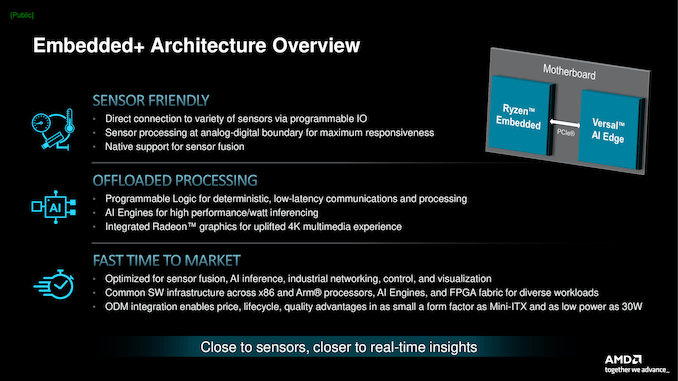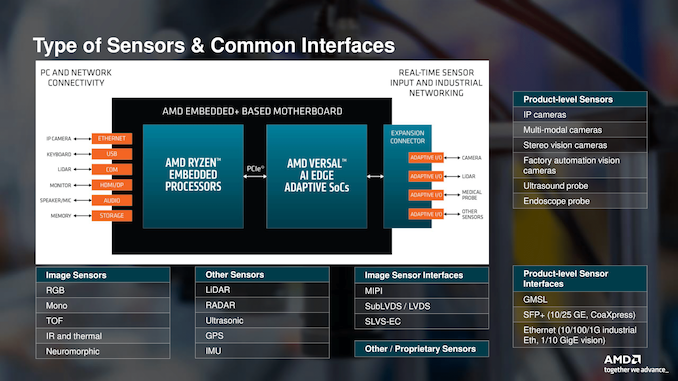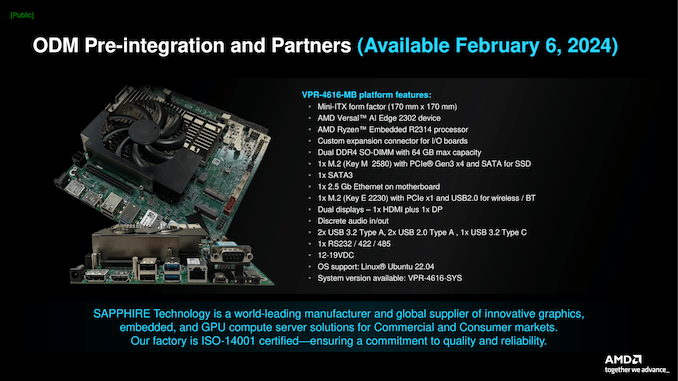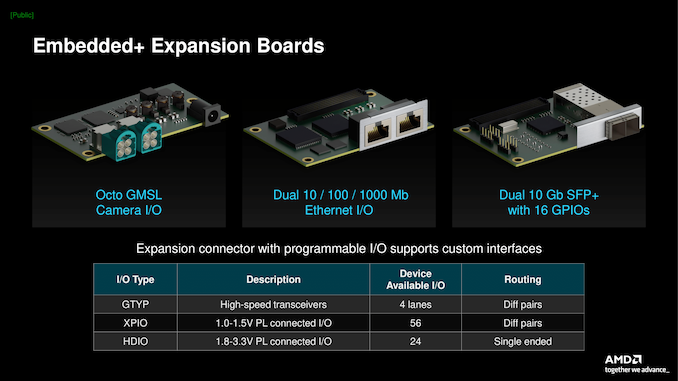One area of AMD’s product portfolio that hasn’t received as much attention as its desktop and server components is embedded platforms. AMD’s embedded family is important for edge devices, including industrial, automotive, healthcare, digital gaming consoles and thin client systems. Today, AMD launched its latest embedded architecture, Embedded+, which combines Ryzen embedded processors based on the Zen+ architecture with Versal adaptive SoC on one board.
The Embedded+ architecture integrates the capabilities of Ryzen embedded processors and its Versal AI Edge adaptive SoC onto a single package board. AMD is targeting key areas that require good computing power and energy efficiency. This synergy enables Embedded+ to process AI inference and manage complex sensor data in real-time, which is critical for applications in dynamic and demanding environments.

Enabling ODMs to integrate Ryzen Embedded and its Versal SoC onto a single board is particularly beneficial for industries that require low-latency response times between hardware and software, including autonomous vehicles, diagnostic equipment in healthcare, and precision machinery in industrial automation. . AMD Embedded+ architecture can also support a variety of workloads across different processor types, including x86 and ARM, as well as AI engines and FPGA fabrics, providing flexibility and scalability for embedded computing solutions in the industry.

AMD’s Embedded+ platform offers extensive compatibility with a variety of sensor types and their corresponding interfaces. It facilitates direct connection to standard peripherals and industrial sensors via Ethernet, USB and HDMI/DP interfaces. AMD Ryzen Embedded Processors in this architecture can process input from traditional image sensors such as RGB, monochrome, and even advanced neuromorphic types, while supporting industry-standard image sensor interfaces such as MIPI and LVDS.
The AMD Versal AI Edge Adaptive SoC on Embedded+ motherboards further enhances its capabilities by providing adaptive I/O options for real-time sensor input and industrial networking. This includes interfacing with lidar, radar and other sophisticated sensors required by modern embedded systems in industrial, medical and automotive sectors. The platform supports a variety of production-grade sensor interfaces such as GMSL and Ethernet-based vision protocols, which means it is designed to be integrated into complex sensor-driven systems.

AMD also announced new pre-integrated solutions, available to ODMs starting today. The Sapphire Technology VPR-4616-MB platform is a compact Mini-ITX form factor motherboard powered by the AMD Versal AI Edge 2302 SoC combined with the AMD Ryzen Embedded R2314 processor based on Zen+ with 4C/4T and 6 Radeon Vega computing unit. It features custom expansion connectors for I/O boards and supports multiple connectivity options, including dual DDR4 SO-DIMM slots with capacities up to 64 GB, 1 PCIe 3.0 x4 M.2 slot and 1 for legacy In addition to SATA ports for HDDs and SSDs, the VPR-4616-MB also has a good set of networking features, including 2.5 Gb Ethernet and an M.2 Key E 2230 PCIe x1 slot for wireless interfaces. It also supports the Linux-based Ubuntu 22.04 operating system.

Also announced are a series of expansion boards that significantly expand support for Embedded+ architectures. What’s particularly noteworthy about the Octo GMSL Camera I/O Board is its ability to interface with multiple cameras simultaneously. There is no doubt that it is suitable for high-bandwidth vision-based systems and is an integral part of areas such as advanced driver assistance systems (ADAS) and automatic monitoring systems. These systems often require the integration of a large number of image inputs for real-time processing and analysis, and the Octo GMSL board is designed to meet this need.
In addition, dual Ethernet I/O boards are provided, capable of supporting 10/100/1000 Mb connections to meet environments requiring high-speed network communications. Dual 10 Gb SFP+ boards feature 16 GPIOs to meet higher bandwidth requirements, providing sufficient data transfer rates for tasks such as real-time video streaming and large-scale sensor data aggregation. These expansion options expand the capabilities of the Embedded+ architecture in edge and industrial scenarios.
The Sapphire VPR-4616-MB is available for customer purchase now and comes with a complete system configuration including storage, memory, power supply and chassis.